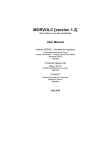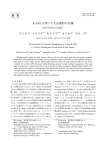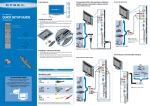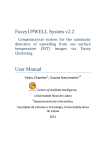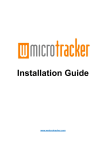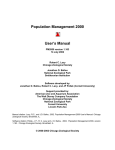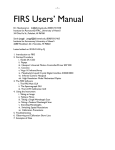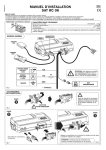Download here - Instituto CEDIAC - Universidad Nacional de Cuyo
Transcript
NETVOLC [version 1.1] http://cediac.uncu.edu.ar/software User Manual Instituto CEDIAC - Facultad de Ingeniería Universidad Nacional de Cuyo Centro Universitario – Parque General San Martín Mendoza (5500) Argentina Fundación Miguel Lillo Miguel Lillo 251 (4000) San Miguel de Tucumán Argentina CONICET National Scientific and Technical Research Council Argentina July 2014 Table of Contents 1. INTRODUCTION .......................................................................................................... 3 1.1 1.2 Related Documents ...................................................................................................................... 3 Contacts ....................................................................................................................................... 3 2. OVERVIEW AND FUNCTIONAL DESCRIPTION .................................................. 4 3. SETUP ............................................................................................................................ 6 3.1 3.2 3.3 3.4 3.5 Download ..................................................................................................................................... 6 Requirements ............................................................................................................................... 6 External function installation ....................................................................................................... 6 NETVOLC installation ................................................................................................................ 7 NETVOLC parameters ................................................................................................................ 7 4. USAGE ......................................................................................................................... 10 2 1. Introduction NETVOLC is an IDL command-line application that computes the outline or boundary of volcanic edifices. It uses a Minimum Cost Flow algorithm jointly with several products derived from a Digital Elevation Model (DEM). An in depth description of the NETVOLC algorithm and its limitations can be found in the documentation indicated in the Related Documents section. This document is intended for those who want to install and use the NETVOLC application. It contains step by step instructions on how to run it. 1.1 Related Documents The related documents for NETVOLC are: Euillades, Leonardo D., Pablo Grosse, and Pablo A. Euillades. “NETVOLC: An Algorithm for Automatic Delimitation of Volcano Edifice Boundaries Using DEMs.” Computers & Geosciences 56 (July 2013): 151–160. doi:10.1016/j.cageo.2013.03.011. Loebel, A. MCF Version 1.3 - A Network Simplex Implementation (version 1.3). Berlin, Germany: Available for academic use free of charge at www.zib.de, 2004. www.zib.de. 1.2 Contacts For comments, assistance or reporting of errors, please contact: Leonardo D. Euillades Instituto CEDIAC – Facultad de Ingeniería Universidad Nacional de Cuyo Phone number: +54 261 4135000 ext 2108 E-mail: [email protected] Pablo Grosse CONICET & Fundación Miguel Lillo Phone number: +54 381 4239723 ext 106 E-mail: [email protected] Pablo A. Euillades Instituto CEDIAC – Facultad de Ingeniería Universidad Nacional de Cuyo Phone number: +54 261 4135000 ext 2108 E-mail: [email protected] For better assistance, please provide us with a detailed description of the error. 3 2. Overview and Functional Description NETVOLC is composed of several IDL programs that are compiled using the IDL version 7.0.1. As mentioned in the Introduction section, NETVOLC also uses external functions and programs. Regarding external functions, NETVOLC employs several functions from the ENVI software for extracting and/or generating DEM-derived products. Concerning external programs, NETVOLC uses two: 1. grep: a Linux command line for regular expression analysis. 2. mcflight: a solver for Minimum Cost Flow problems. NETVOLC supports batch operation mode. It is intended for analyzing several cases automatically. The user must upload/create a folder containing: 1. A DEM of the whole study area (i.e. a DEM with different volcanoes where the user wants to apply the NETVOLC algorithm). Input DEM must be in the ENVI format and have an associated ENVI header file. 2. A processing parameters text file containing the general parameters to be used. 3. A text file containing the list of volcanoes to be processed. In this mode, NETVOLC creates a singular folder for each volcano present in the list and saves outputs in this folder. The volcanoes list must have a particular format. It consists of a text file where each row corresponds to a volcano to be processed, and each row contains the following parameters separated by blank spaces: Volcano Latitude Longitude winSize_x winSize_y Where: Volcano: user-defined name/id associated to the volcano (the folder created by NETVOLC containing outputs will have this name). Latitude: Latitude (or Northing) of a central point within the volcano (e.g. summit, center of crater) in decimal degrees (or meters). Latitude or Northing will depend on the geographic projection of the supplied DEM. Longitude: Longitude (or Easting) of a central point within the volcano (e.g. summit, center of crater) in decimal degrees (or meters). Longitude or Easting will depend on the geographic projection of the supplied DEM. winSize_x: Dimension (x) in number of pixels of the window to be extracted from the input DEM. 4 winSize_y: Dimension (y) in number of pixels of the window to be extracted from the input DEM. Note that the extracted window should cover the volcano of interest completely, as it defines the maximum possible extension for the resulting outline, but should not be too large, as processing time directly depends on window size; preferentially, inclusion of neighboring volcanoes/landforms should be avoided. The window will be centered on the central point defined above by Latitude (or Northing) and Longitude (or Easting). An example of this file is provided with the test data package. The basic functionality of NETVOLC is schematized below. We advise users to read the article indicated in the Related Documents Section in order to understand the whole processing chain associated to the algorithm. 5 3. Setup 3.1 Download The NETVOLC package (netvolc_v1.1.zip) can be download from: http://cediac.uncu.edu.ar/software/ The package contains the following files: - netvolc_v1.1.sav: the NETVOLC programs. input_param.txt: a file containing necessary input parameters. calcENVIProd.pro: ENVI product generation programs. enviUtilityLib.pro: Read/Write ENVI products routines. polygonROI_v2.pro: Routines for writing output as ROI ENVI format. compile.go: Script for compiling and restoring netvolc suite. mcf-1.3.tgz: a version of the MCF library. mariana.zip: test data consisting of a DEM of the Mariana volcanic islands. 3.2 Requirements NETVOLC requires a PC or Virtual machine with Linux or Windows operating system and ENVI/IDL 4.5 or later installed. In a Linux environment, a C/C++ compiler must be present. In a Windows environment, Cygwin (provided) or a Linux Virtual Machine with C/C++ compiler capabilities must be present. In both cases, C/C++ compiler capabilities assumes availability of make and gcc utilities. 3.3 External function installation Installation depends on the installed Operating System. Linux MCF installation. A version of the MCF library is distributed with NETVOLC. Installation requires the following steps to be executed in a terminal: 1. Uncompress the MCF suite: tar –xvf mcf-1.3.tgz 2. Go to the extracted folder mcf-1.3/gnu-make: cd mcf-1.3/gnu-make 3. Create an environmental variable referencing the operating system: export ARCH=”Linux” 4. Compile the source code: make 5. Install: make install 6 Note: executable will be installed in a folder named bin.Linux inside mcf1.3 folder. Created files must be: libmcf.a, mcf and mcflight 6. Copy compiled files to a bin folder in your Linux distribution (i.e. /usr/local/bin) in order to be accessible to anyone. Windows In a Windows OS, the NETVOLC dependence on external Linux functions can be solved by using Cygwin. Installation requires the following steps to be executed in a Cygwin terminal. 1. Uncompress the MCF suite: tar –xvf mcf-1.3.tgz 2. Go to folder mcf-1.3/gnu-make: cd mcf-1.3/gnu-make 3. Create an environmental variable referencing the operating system: export ARCH=”Cygwin” 4. Compile the source code: make 5. Install: make install Note: executable will be installed in a folder named bin.Cygwin inside mcf-1.3 folder. Created files must be: libmcf.a, mcf and mcflight 6. Copy compiled files to a bin folder in your Cygwin installation directory (i.e. c:\cygwin\bin) in order to be accessible to anyone. 7. Rename mcflight file (inside c:\cygwin\bin) to mcflight.exe. NOTE: In version 1.1 mcf-1.3.tgz has been updated in order to obtain greater compatibility with 64-bits systems. It is not necessary to install mcf-1.3.tgz again if it has been installed previously. 3.4 NETVOLC installation It doesn’t require a specific installation. A new distribution way have been implemented in order to obtain greater compatibility with several ENVI/IDL versions. Now, a series of IDL source files (.pro), pre-compiled files (netvolc_v1.1.sav) and an IDL compilation script are distributed. All files must be copied in the folder where users want to execute the algorithm and setting up the input_param.txt and volcanoes.txt file if necessary. NOTE: templateVolcanoes.sav is now obsolete. 3.5 NETVOLC parameters 7 The following are the parameters associated to NETVOLC. They are present in the file named input_param.txt, which must be located in the folder where NETVOLC will be executed. The user should set up/modify the parameters as desired before running NETVOLC; see Euillades et al. (2013) for details. NOTE: Don’t use Windows Notepad for modifying the input-param.txt file. Instead use Notepad++, Microsoft WordPad o any other text processor. [BATCH] dem=Mariana_UTM55N_dem ;DEM file name volcanoesList=volcanoes.txt ;Volcanoes file name [ENVIRONMENT] appMCF=mcflight ;MCF solver appGREP=grep ;grep command [NETVOLC] net_plot_triang=y polar_plot_triang=y perc_threshold=100 perc_threshold_arcs=99 bin_size=1 ang_threshold=5 smooth_width=2 min_threshold_separation=0 max_threshold_separation=200 use_dem=n min_dem_height_filter=2000 max_dem_height_filter=4300 use_slope=n ;flag indicating if network triangulation plot is desired (y/n). Default is y. ;flag indicating if polar coordinate network triangulation plot is desired (y/n). Default is y. ;percentage of arcs to be considered based on its cost. Default is 100. ;percentage of arcs to be considered based on its length. Default is 99. ;bin size for estimating histogram (see idl histogram documentation). Default is 1. ;border to be considered in the polar coordinate system for linking fictitious nodes to the network (in degrees). It means that nodes with an azimuth polar coordinate value within (−180; -180+ang_threshold) degrees will be linked to the supply node. Nodes with an azimuth polar coordinate value within (180ang_threshold; 180) degrees will be linked to the demand node. Default is 5. ;smoothing factor of the final solution: default is 2. ;minimum radial distance (in pixel units) from the central point of the solution. Default is 0. ;maximum radial distance (in pixel units) from the central point of the solution. Default is equal or greater to window size extracted from the DEM. ;flag indicating if height information must be considered (y/n). Default is n. ;minimum height of the solution (if use_dem flag is set to y). ;maximum height of the solution (if use_dem flag is set to y). ;flag indicating if slope information must be 8 considered (y/n). Default is n. slope_factor=1. iterations=10 overflow=1.e+07 stdev_factor=1 cancel_strategy=a ; factor establishing the influence of slope on the solution (when slope_factor flag is set to y). Default is 1. ;number of iterations to be performed. Default is 10. ;number considered an overflow. It is used for filtering arcs with an associated cost greater than this value. Default is 1.e+07. ;number of standard deviations to be considered when statistics are calculated. Default is 1. ; It is used for reducing the network in every iteration. a: indicates network must be reduced cancelling arcs. n: indicates network must be reduced cancelling nodes. Default is a. [ENVI] KERNEL=3 SHADED_RELIEF_AZIMUTH=45 SHADED_RELIEF_ELEVATION=45 ;kernel to be used for estimating DEM derived products. Default is 3. ;azimuthal angle to be used for calculating shaded relief product. Default is 45. ;elevation angle to be used for calculating shaded relief product. Default is 45. For the Windows environment, the section [ENVIRONMENT] in parametros_batch.txt file must be replaced by: [ENVIRONMENT] appMCF= c:\cygwin\bin\mcflight ;MCF solver appGREP= c:\cygwin\bin\grep ;grep command Considering a Cygwin installation in the path: c:\cygwin. 9 4. Usage Once installed, we recommend testing NETVOLC with the supplied test data package in order to verify the correct installation and functionality. The simple procedure indicated next for processing the test data can be used as a usage guide for the final user. 1. Create a folder. Henceforth, we will refer to this folder as netvolc folder. 2. Extract the test data (mariana.zip) into the netvolc folder. The test data is composed of the following files: a. Mariana_UTM55N_dem with ancillary data (Mariana_UTM55N_dem.hdr) b. volcanoes.txt 3. Copy the following files to the netvolc folder: a. netvolc_v1.1.sav b. input_param.txt c. calcENVIProd.pro d. enviUtilityLib.pro e. polygonROI_v2.pro f. compile.go 4. Update section [ENVIRONMENT] inside input_param.txt file in order to reflect the location of the external functions. 5. Open an IDL session. In the command line, place yourself inside the netvolc folder. 6. Compile y restore functions by typing: @compile.go 7. Execute netvolc by typing: netvolc In this way, the volcanoes listed in volcanoes.txt will be processed by the NETVOLC algorithm and results will be distributed in a folder per volcano within the netvolc folder. For each volcano, output will consist in the following files: a. A [volcano_name].roi file associated to the input DEM with the volcano edifice outline. It is an ENVI/IDL ROI file that can be restored using the ENVI suite. It can be used as an input parameter for MORVOLC (see the corresponding User Manual). b. A [volcano_name]_nodes.roi file associated to the input DEM with the list of points corresponding to the volcano edifice outline (same than above but nodes are not linked between them). It is an ENVI/IDL ROI file that can be restored using the ENVI suite. c. Several intermediate DEM derived products and the cost map used in the estimation of the edifice outline. In order to process a different area than the example, the following steps must be reproduced: 10 1. Make available a DEM of your area of interest and place it inside the netvolc folder. 2. Create a volcanoes file (volcanoes.txt) as indicated in the previous section. Note: every line in this folder starting with a # character will be skipped. 3. Set up the input_param.txt as desired (see above). 4. Follow steps 4-8 of the test data procedure. NOTE: if a failure occurs during NETVOLC execution (i.e. mcflight is not found), NETVOLC will be stopped with an error. In order to restart the NETVOLC execution, the following steps must be carried out just after failures have been identified and solved: - Exit from any IDL procedure: RETALL Place yourself inside the netvolc folder. Restart netvolc procedure by typing: netvolc 11











